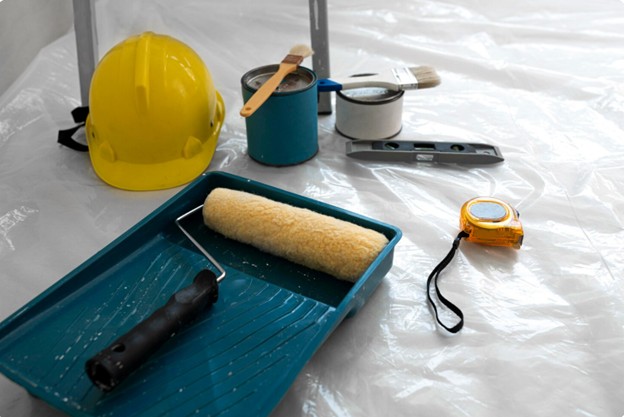Completing interior painting after a basement remodeling project requires special attention to moisture, lighting, and material selection. Basement environments present specific challenges that differ from upper-level rooms, making proper preparation and product choice essential for long-lasting results. Knowing about these factors helps ensure your newly remodeled basement maintains its fresh appearance for years to come.
Moisture Management Before Painting
Basement remodeling creates dust and humidity that must be addressed before beginning interior painting work. Even with proper ventilation during construction, moisture levels may remain increased from concrete curing, joint compound drying, and general construction activities. Allow adequate drying time after completing all wet work before starting paint application.
Dehumidifiers help stabilize moisture levels and should run continuously for several days before painting begins. Target humidity levels below 50% for optimal paint adhesion and curing. High humidity can prevent proper paint film formation and lead to poor adhesion or extended drying times.
Moisture meters can verify that surfaces are ready for painting. Concrete walls, new drywall, and wood surfaces should register appropriate moisture levels before primer or paint application. Rushing this step often results in paint failure and requires complete repainting of affected areas.
Surface Preparation for New Construction
New drywall in basement remodeling projects requires thorough cleaning to remove construction dust and debris. Use tack cloths or microfiber materials to remove all particles that could interfere with paint adhesion. Vacuum all surfaces, including walls, ceilings, and trim work.
Joint compound areas need special attention during surface preparation. Sand any ridges or imperfections smooth, then wipe clean before priming. Differences in surface texture between drywall paper and joint compound can show through paint if not properly addressed during preparation.
Primer application is essential on all new surfaces in basement environments. Bare drywall, wood trim, and any repaired areas require appropriate primer for the specific substrate. This step ensures uniform paint appearance and provides the best foundation for topcoat adhesion.
Paint Selection for Basement Environments
Moisture-resistant paint formulations provide better performance in basement settings compared to standard interior paints. These products contain additives that resist mold and mildew growth while maintaining their appearance in higher humidity conditions. The slight additional cost pays dividends in longevity and maintenance requirements.
Sheen levels affect both appearance and practicality in basement spaces. Satin and semi-gloss finishes resist moisture better than flat paints and are easier to clean. However, higher sheen levels show imperfections more readily, requiring better surface preparation.
Color selection impacts how basement spaces feel and function. Lighter colors reflect available light and help spaces feel larger and brighter. Dark colors can create cozy atmospheres but may make spaces feel smaller and require more artificial lighting for adequate illumination.
Addressing Concrete Block & Foundation Walls
Concrete surfaces require special preparation and products for successful interior painting. Efflorescence, the white mineral deposits that appear on concrete, must be completely removed before painting. Wire brushing and cleaning solutions designed for masonry surfaces prepare these areas properly.
Masonry primer specifically formulated for concrete and block surfaces provides the best foundation for paint adhesion. These products penetrate porous surfaces and create a stable base for topcoat application. Standard primers may not adhere properly to alkaline masonry surfaces.
Basement remodeling often includes covering foundation walls with drywall, but exposed concrete areas still require proper treatment. Consider the long-term implications of paint versus other coating systems for these surfaces, as concrete continues to cure and may develop minor cracks over time.
Lighting Considerations During Application
Basement lighting affects color perception and paint application quality. Temporary work lighting should supplement existing fixtures to ensure proper coverage and avoid missed areas. LED work lights provide bright, consistent illumination that reveals surface imperfections and ensures thorough coverage.
Color appearance changes significantly under different lighting conditions. Test paint colors in various lighting situations, including artificial lighting used in the basement and any available natural light. What looks good under bright work lights may appear different under normal use conditions.
Paint application timing should account for lighting limitations. Working in poorly lit areas increases the likelihood of roller marks, brush strokes, and uneven coverage that become apparent under proper lighting conditions.
Ventilation & Air Quality
Proper ventilation during interior painting protects air quality and ensures proper paint curing. Basement ventilation may be limited compared to upper floors, making mechanical ventilation more important. Exhaust fans and dehumidifiers should operate continuously during painting and curing periods.
Low-VOC or zero-VOC paint products improve air quality during and after application. These formulations cure properly in basement environments while reducing chemical odors that can be trapped in lower-level spaces with limited air circulation.
Air filtration helps remove paint fumes and particles from basement air. Portable air cleaners with appropriate filters can supplement existing ventilation systems and improve working conditions during application.
Temperature Control for Optimal Results
Basement temperatures may be cooler than recommended for paint application and curing. Most paints require temperatures above 50°F for proper application and curing. Heating systems should maintain appropriate temperatures throughout the painting process.
Temperature fluctuations can affect paint application and final appearance. Consistent temperatures during application and initial curing produce the best results. Avoid painting during periods of extreme temperature changes that might affect paint performance.
Surface temperatures differ from air temperatures, particularly on concrete walls and floors. These surfaces may be cooler than air temperature and could affect paint adhesion and curing if not properly managed.
Trim & Detail Work
Basement remodeling often includes new trim and millwork that requires careful attention during interior painting. Caulking gaps between trim and walls before painting creates clean, finished appearances. Use paintable caulk appropriate for the specific materials being joined.
Cut lines between walls and trim require steady hands and proper technique. Quality brushes and appropriate paint consistency help achieve clean, straight lines. Take time with detail work, as it significantly impacts the overall appearance of the finished space.
Multiple thin coats typically provide better results than single thick applications, particularly on trim work. This approach allows better flow and leveling while reducing the risk of runs and drips that can be difficult to correct.
Quality Control & Final Inspection
Systematic inspection during and after painting helps identify areas that need attention. Work in sections and inspect each area under proper lighting before moving to the next section. Address any issues immediately while paint is still workable.
Touch-up paint should come from the same batch used for the main application to ensure color matching. Reserve adequate paint for future touch-ups and maintenance, as color matching can be difficult once paint has aged.
Documentation of paint colors, brands, and finish types helps with future maintenance and touch-up work. Store this information with other basement remodeling records for easy reference when repairs or updates become necessary.
Proper interior painting after basement remodeling requires attention to environmental factors, surface preparation, and product selection specific to below-grade conditions. Taking time to address these considerations ensures your newly remodeled basement maintains its appearance and provides years of enjoyment.

